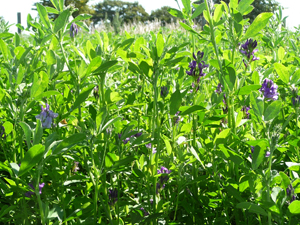Meadow grazing provides dairy cattle with quality feed which is available at low cost. Fresh green fodder is rich in proteins, especially a grass-legume combination that can mobilise atmospheric nitrogen. In addition, the meadow improves the soil organic matter content as well as limiting erosion and the risk of nitrate leaching. It also acts as a carbon sink and has a very favourable effect on biodiversity.
Of all the forage legumes, lucerne, commonly found in hay meadows, provides the best dry matter and protein yield per hectare. It is drought-tolerant thanks to its taproot which collects water and minerals at depth, thus helping to decompact the soil and bring nutrients up towards the surface. In nutritional terms lucerne is rich in calcium, phosphorus, magnesium and trace elements.
Optimum use as fodder is limited by the fact that most of the proteins are in the leaves. As significant leaflet loss can occur during wilting, the quality of the hay and silage is thus impaired.
In September 2011, as part of the GrassMilk project, the CRA-W's dairy herd grazed on lucerne (second cut, with less than 5% cocksfoot) without any metabolic disorders ensuing. The crop was allowed to grow for 5-6 weeks and the plot size was limited so that 10 kg DM lucerne/day was available to the cattle. This was supplemented by 3.5 kg DM silage maize and 3.6 kg DM concentrate (plus a production concentrate). The cattle mainly stripped the leaves from the plants, leaving the tougher stems. The sustainability of the lucerne field was not affected by this grazing scheme.
Neither the milk production nor the quantities ingested were affected. Compared with grazing on perennial rye-grass, only the fatty acid pattern, the average urea content (29.83 mg/dl as against 19.20 mg/dl in the case of rye-grass) and the average butterfat content (3.6 compared with 3.89 for rye-grass) differed significantly. The milk produced on lucerne was proportionally richer in polyunsaturated fatty acids (omega 3 and 6 in particular) and conjugated linoleic acid (CLA), which are reputed to have human health benefits.
Grazing on lucerne is therefore thought to produce quality milk as well as being kind to the environment and the farmer's wallet, thereby making farmers more autonomous as regards ration protein management and eliminating the nitrogen fertilizer and fossil fuel cost components.
